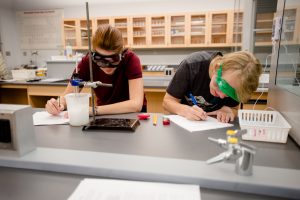 The pace of the academic semester picks up in mid April, with students and faculty alike realizing that the end of the semester is looming. Students hustle to complete projects and papers, but I am especially impressed by the number of research activities in which CSA undergraduates are involved.
The pace of the academic semester picks up in mid April, with students and faculty alike realizing that the end of the semester is looming. Students hustle to complete projects and papers, but I am especially impressed by the number of research activities in which CSA undergraduates are involved.
Michigan Tech has sought to connect students to research as early as possible in their time here, believing that research, like other experiential activities, can transform their education. The following list of their work is, I believe, impressive.
In Biological Sciences, fourth-year Biological Sciences student Rebecca Hobmeier recently presented a department seminar on “Drosophila Gene Regulation in the Formation of Complex Color Patterns in Yellow Evolution of Guttifera.” Thomas Werner was her adviser.
In the Physics Department, a number of seniors presented summaries of their projects at a department colloquium. These included:
- Floyd Johnson — “Free-standing and Substrate-Supported Cytosine Molecules: Molecular Dynamics Study, advised by department chair Ravi Pandey
- Austin Hermann — “Quantum Confinement Effect in Silicon,” advised by Ranjit Pati
- Colin Sheidler —”Unidirectional Emission from Microring Lasers,” advised by Ramy El-Ganainy
- David Russell — “A Search for Exotic Particles Using AUGER Data”, advised by Brian Fick
- Michael Foetisch — “Iron Electrowinning: Proof of Concept and Optimization,” advised by Timothy Eisele
- Nick Videtich — “Pico-second Pulsed Laser System Using Neodymium-doped Yttrium Vanadate Crystal,” advised by Jae Yong Suh
- Kelci Mohrman — “Searching for Emission from the Geminga Pulsar Wind Nebula in GeV Engines,” advised by Petra Huentemeyer.
And in Social Sciences, three students presented their undergraduate theses in anthropology to the department.
- James Wezensky — Stamp Mill Technologies: The Industrial Past of Isle Royale National Park, advised by Pat Martin
- Jakob Williams — The Party of Trump: Understanding the Rise of the Billionaire Populist, advised by Melissa Baird
This list could be multiplied many times, as faculty in the life sciences (especially Biological Sciences, Chemistry and Kinesiology) eagerly recruit undergraduates to work in their labs, so that some of them leave Michigan Tech as co-authors or contributors to a publication in an academic journal. These outcomes explain why many of us talk about the unity of teaching and research and see them as deeply complementary activities. These student projects offer only the most recent example of effort to integrate these core responsibilities.